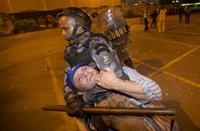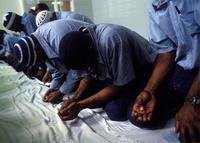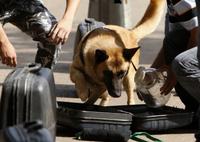-
World Cup security teams focus more on crime, protests – less on terrorism

During the 2014 FIFA World Cup, currently being held across twelve different venues across Brazil, security teams have extensively prepared for measures to be taken against crime and protest related to heated political unrest. American bomb-busting robots, Israeli surveillance drones, and German anti-aircraft tanks — an international assortment of security officials and measures – are just some of the pieces of the greater security apparatus protecting both players and fans.
-
-
A first: Armed robber convicted based on Chicago’s facial recognition technology
Pierre Martin became the first person in Chicago to receive a prison sentence after being convicted based on evidence from the city’s facial recognition technology, NeoFace. Martin was sentenced Monday to twenty-two years for two armed robberies carried out on the Chicago Transit Authority(CTA) train system in January and February 2013. A few weeks after the incidents, Chicago Police Department officials announced that Marin was identified using facial recognition software.
-
-
House passes measure requiring review of intelligence sharing practices
In the bill is the first legislation written in response to shortcomings revealed by the Boston marathon bombings,the House of Representatives last Friday approved a measure which requires the FBI, DHS, and the Office of the Director of National Intelligence to review their information sharing practices and report back to Congress within ninety days. Post-bombing investigation concluded that had intelligence agencies shared information on Tamerlan Tsarnaev, one of the suspects in the Boston Marathon bombings, prior to the incident, local law enforcement authorities may have been able to monitor Tsarnaev’s actions.
-
-
Hitting the reset button on Secure Communities
Last Tuesday law enforcement officials said they anticipate a “reboot” of the controversial immigration enforcement program, Secure Communities, in which police officers are asked to submit fingerprints taken by police to DHS so the individuals stopped by the police can be screened for deportation eligibility. Critics argue the program leads to too many low-level criminals and non-criminals being turned over to immigration authorities, and in addition to the cost involved in the process, the program could make witnesses and victims of crime reluctant to cooperate with law enforcement.
-
-
New technology tests ammo while saving joints
Firing and testing thousands of rounds of ammunition weekly can challenge the human body — even ones in top physical condition — causing debilitating stress injuries and chronic nerve and joint pain. DHS Science and Technology Directorate (S&T), with the help of agents from ICE Office of Firearms and Tactical Programs (OFTP) Armory Operations Branch (AOB), has taken an important step forward in reducing or eliminating these injuries by developing of the “Virtual Shooter.”
-
-
DOJ, NIST team up to shore up forensic science, but skeptics question effort
Five years ago, a report on the state of forensic science by the National Academy of Sciences decried the lack of sound science in the analysis of evidence in criminal cases across the country. It spurred a flurry of outrage and promises, but no immediate action. Now, renewed efforts are underway, with the Department of Justice (DOJ) and the National Institute of Standards & Technology (NIST) teaming up to create a National Commission on Forensic Science.
-
-
Forensic DNA technology could help identify abducted Nigerian girls
Forensic DNA technology developed in the aftermath of the 9/11 attacks could be used to identify and reunite more than 200 Nigerian girls who were kidnapped by Islamist militants, scientists said. The software, Mass Fatality Identification System (M-FISys), has been used worldwide — in Mexico, Guatemala, El Salvador, Honduras, Perú, Sri Lanka, the Philippines, Thailand, Malaysia, among several other countries — to identify and return more than 700 children who were abducted by criminals for child trafficking.
-
-
Sinn Féin’s president Gerry Adams arrested over 1972 murder
Sinn Féin president Gerry Adams was arrested on Wednesday for questioning about one of the most notorious IRA murders during the Troubles. Detectives in Antrim questioned Adams about the execution of Jean McConville, a widowed mother of 10 who was dragged from her west Belfast home in 1972, tortured, and shot in the back of the head. McConville was one of the “Disappeared” – IRA victims whose bodies were buried so they would never be found — and her body was not discovered until 2003. Adams’s arrest and questioning follows a ruling by a court in the United States which compelled Boston College to hand over to the Police Service of Northern Ireland recorded interviews with veteran IRA members about McConville’s murder.
-
-
U.S. should significantly reduce incarceration rate: study
There has been an unprecedented and internationally unique rise in U.S. state and federal prison populations, from 200,000 inmates in 1973 to 1.5 million in 2009. This increase occurred because of policy decisions such as mandatory sentencing, long sentences for violent and repeat offenses, and intensified criminalization of drug-related activity. Given the minimal impact of long prison sentences on crime prevention and the negative social consequences and burdensome financial costs of U.S. incarceration rates, which have more than quadrupled in the last four decades, the United States should revise current criminal justice policies to significantly reduce imprisonment rates, says a new report from the National Research Council. The dramatic rise in prison population “not serving the country well,” the report says.
-
-
Violence and corruption by drug cartels hits homeland
While the American media devotes much time and effort to pinpointing the violence and corruption generated by the drug cartels in Mexico, far less attention is devoted to crimes in this country which are a direct result of these same criminal organizations. The corruption of American law enforcement has become a significant problem along the border. The Mexican drug cartels which control drugs and human smuggling are directly responsible for a spiraling level of violence and crime which instills fear among residents on both sides of the border even as it lowers the quality of life for all who call the U.S.-Mexican borderlands their home.
-
-
Tiny particles could help verify goods

Chemical engineers hope smartphone-readable microparticles could crack down on counterfeiting. Some 2 to 5 percent of all international trade involves counterfeit goods, according to a 2013 United Nations report. These illicit products — which include electronics, automotive and aircraft parts, pharmaceuticals, and food — can pose safety risks and cost governments and private companies hundreds of billions of dollars annually. Researchers have invented a new type of tiny, smartphone-readable particle that they believe could be deployed to help authenticate currency, electronic parts, and luxury goods, among other products. The particles, which are invisible to the naked eye, contain colored stripes of nanocrystals that glow brightly when lit up with near-infrared light.
-
-
U.K. prisons serve as recruitment centers for jihadi causes

A recent report details the growing population of Muslims in British jails, many of whom are declared Islamic extremists. Top-security prison Whitemoor, home to many extremists serving life sentences for plotting acts of terror in the United Kingdom, is considered a recruitment center for al-Qaeda, according to prison inspectors. Roughly 42 percent of prisoners at Whitemoor are Muslims, a stark contrast to the overall U.K. population in which only 5 percent practice Islam.In all, there are 11,729 Muslims in British jails, about one in seven of all inmates.
-
-
Gangbangin' in Syria: Two L.A. gang members in Syria to defend Assad regime
About a hundred Americans have gone to Syria to take part in the war, all of them — with the apparent exception of two L.A. gang members named “Creeper” and “Wino” — to fight on the side of the Sunni rebels against the Alawite Assad regime. In a video recently posted on YouTube, the two are shown brandishing AK-47s and firing at an unseen enemy. Their tattoos identify one of them as a member of Sureños-13, which is affiliated with the Mexican mafia, and the other as a member of Westside Armenian Power gang. They tell the camera they are “in Syria, gangbangin’.”
-
-
How dogs detect explosives: New training recommendations

Researchers have helped determine the science behind how canines locate explosives such as Composition C-4 (a plastic explosive used by the U.S. military). The study found the dogs react best to the actual explosive, calling into question the use of products designed to mimic the odor of C-4 for training purposes.
-
-
Secure Communities triggers deportation of undocumented immigrants with no criminal records
The U.S. Immigration and Customs Enforcement’s (ICE) Secure Communitiesprogram sends fingerprint data from local law enforcement and the Federal Bureau of Investigationto immigration officers to identify and deport illegal immigrants who commit major crimes. The program has expanded from fourteen jurisdictions in 2008 to more than 3,000 today. Immigration advocates say that the program’s emphasis on identifying and deporting undocumented immigrants who have committed crimes in the United States notwithstanding, it has also triggered the deportation of 5,964 undocumented immigrants with no criminal records.
-
More headlines
The long view
How Male Grievance Fuels Radicalization and Extremist Violence
Social extremism is evolving in reach and form. While traditional racial supremacy ideologies remain, contemporary movements are now often fueled by something more personal and emotionally resonant: male grievance.
